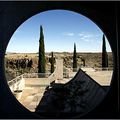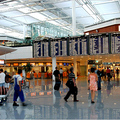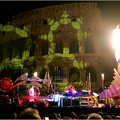THE WORLD WITHOUT US
By Alan Weisman.
Illustrated. 324 pp. Thomas Dunne Books/St. Martin’s Press. $24.95.
When Rachel Carson’s “Silent Spring” was published in 1963, the chemical giant Monsanto struck back with a parody called “Desolate Spring” that envisioned an America laid waste not by pesticides but by insects: “The bugs were everywhere. Unseen. Unheard. Unbelievably universal. ... On or under every square foot of land, every square yard, every acre, and county, and state and region in the entire sweep of the United States. In every home and barn and apartment house and chicken coop, and in their timbers and foundations and furnishings. Beneath the ground, beneath the waters, on and in limbs and twigs and stalks, under rocks, inside trees and animals and other insects — and yes, inside man.”
To Alan Weisman, this nightmare scenario would be merely a promising start. In his morbidly fascinating nonfiction eco-thriller, “The World Without Us,” Weisman imagines what would happen if the earth’s most invasive species — ourselves — were suddenly and completely wiped out. Writers from Carson to Al Gore have invoked the threat of environmental collapse in an effort to persuade us to change our careless ways. With similar intentions but a more devilish sense of entertainment values, Weisman turns the destruction of our civilization and the subsequent rewilding of the planet into a Hollywood-worthy, slow-motion disaster spectacular and feel-good movie rolled into one.
A journalist and author of three previous books, Weisman travels from Europe’s last remnant of primeval forest to the horse latitudes of the Pacific, interviewing everyone from evolutionary biologists and materials scientists to archaeologists and art conservators in his effort to sketch out the planet’s post-human future. In even the most heavily fortified corners of the settled world, the rot would set in quickly. With no one left to run the pumps, New York’s subway tunnels would fill with water in two days. Within 20 years, Lexington Avenue would be a river. Fire- and wind-ravaged skyscrapers would eventually fall like giant trees. Within weeks of our disappearance, the world’s 441 nuclear plants would melt down into radioactive blobs, while our petrochemical plants, “ticking time bombs” even on a normal day, would become flaming geysers spewing toxins for decades to come. Outside of these hot spots, Weisman depicts a world slowly turning back into wilderness. After about 100,000 years, carbon dioxide would return to prehuman levels. Domesticated species from cattle to carrots would revert back to their wild ancestors. And on every dehabitated continent, forests and grasslands would reclaim our farms and parking lots as animals began a slow parade back to Eden.
A million years from now, a collection of mysterious artifacts would remain to puzzle whatever alien beings might stumble upon them: the flooded tunnel under the English Channel; bank vaults full of mildewed money; obelisks warning of buried atomic waste (as current law requires) in seven long-obsolete human languages, with pictures. The faces on Mount Rushmore might provoke Ozymandian wonder for about 7.2 million more years. (Lincoln would probably fare better on the pre-1982 penny, cast in durable bronze.) But it’s hard to imagine an alien archaeologist finding poetry in the remote Pacific atolls awash in virtually unbiodegradable plastic bottles, bags and Q-tip shafts, or in the quadrillions of nurdles, microscopic plastic bits in the oceans — they currently outweigh all the plankton by a factor of six — that would continue to cycle uncorrupted through the guts of sea creatures until an enterprising microbe evolved to break them down.
As for the creatures who made this mess, the only residue of our own surprisingly negligible biomass — according to the biologist E. O. Wilson, the six billion-plus humans currently wreaking planetary havoc could all be neatly tucked away in one branch of the Grand Canyon — would be the odd fossil, mingling perhaps with the limbs of Barbie dolls.
Weisman knows from the work of environmental historians that humans have been shaping the natural world since long before the industrial age. His inner Deep Ecologist may dream of Earth saying good riddance to us, but he finds some causes for hope amid the general run of man-bites-planet bad news. At Amboseli National Park in Kenya, he takes comfort in the spectacle of Masai herdsmen living in carefully managed harmony with predators and grazers alike. In the 30-kilometer-radius “Zone of Alienation” around the Chernobyl nuclear plant, where some bridges remain too hot to cross 20 years after the 1986 meltdown, he finds eerie peace in the forests full of moose, lynx and radioactive deer. Watching from inside his protective suit as barn swallows buzz around the reactor, Weisman writes: “You want them to fly away, fast and far. At the same time, it’s mesmerizing that they’re here. It seems so normal, as if apocalypse has turned out to be not so bad after all. The worst happens, and life still goes on.”
So could we ourselves really simply fly away, leaving the rest of nature to slowly clean up our mess? Doomsday rhetoric aside, the fact is that nothing is likely to wipe us out completely, at least not without taking a good chunk of the rest of creation with us. (Even a virus with a 99.99 percent kill rate would still leave more than half a million naturally immune survivors who could fully repopulate the earth to current levels in a mere 50,000 years.) Not that some people aren’t trying to take matters into their own hands. Weisman checks in with Les Knight, the founder of the Voluntary Human Extinction Movement, which advocates gradually putting our species to sleep by collective refusal to procreate. After an initial panic, we would look around and see that the world was actually getting better: “With no more resource conflicts, I doubt we’d be wasting each other’s lives in combat,” Knight says. “The last humans could enjoy their final sunsets peacefully, knowing they have returned the planet as close as possible to the Garden of Eden.” (Apparently he never saw “Children of Men.”)
Weisman has his own flirtation with religious language, his occasionally portentous impassivity giving way to the familiar rhetoric of eco-hellfire as he imagines the earth’s most “narcissistic” species cleansed from the earth as punishment for its “overindulged lifestyle.” But Weisman stops short of calling for our full green burial, arguing instead for a universal “one child per human mother” policy. It would take until 2100 to dwindle to a global population of 1.6 billion, a level last seen in the 19th century, before leaping advances in energy, medicine and food production, but well before then we’d experience “the growing joy of watching the world daily become more wonderful.” And the evidence, Weisman writes, “wouldn’t hide in statistics. It would be outside every human’s window, where refreshed air would fill each season with more birdsong.”
Even readers who vaguely agree that there are “too many of us” (or is it too many of them?) may not all share Weisman’s brisk certainty that trading a sibling for more birdsong is a good bargain, just as those who applaud the reintroduction of the North American wolf may not quite buy the claim by Dave Foreman, a founder of Earth First!, that filling the New World’s empty über-predator niche with African lions and cheetahs is our best chance to avoid what Weisman calls “the black hole into which we’re shoving the rest of nature.” In the end, it’s the cold facts and cooler heads that drive Weisman’s cautionary message powerfully home. When it comes to mass extinctions, one expert tells him, “the only real prediction you can make is that life will go on. And that it will be interesting.” Weisman’s gripping fantasy will make most readers hope that at least some of us can stick around long enough to see how it all turns out.







